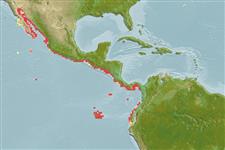Cetengraulis mysticetus (Günther, 1867)
Pacific anchoveta
Add your observation in Fish Watcher
| Native range | All suitable habitat | Point map | Year 2050 |

|
| This map was computer-generated and has not yet been reviewed. |
| Cetengraulis mysticetus AquaMaps Data sources: GBIF OBIS |
Upload your photos and videos
Pictures | Google imageCetengraulis mysticetus
Picture by Robertson, R.
Pictures | Google imageCetengraulis mysticetus
Picture by Robertson, R.
Colombia country information
Common names:
Anchoveta, Carduma, Cardume
Occurrence: native
Salinity: marine
Abundance: | Ref:
Importance: commercial | Ref: FAO, 1994
Aquaculture: | Ref:
Regulations: | Ref:
Uses: no uses
Comments: Also Ref. 8984, 36754.
National Checklist:
Country Information: https://www.cia.gov/library/publications/resources/the-world-factbook/geos/co.html
National Fisheries Authority:
Occurrences: Occurrences Point map
Main Ref: Whitehead, P.J.P., G.J. Nelson and T. Wongratana, 1988
National Database:
Occurrence: native
Salinity: marine
Abundance: | Ref:
Importance: commercial | Ref: FAO, 1994
Aquaculture: | Ref:
Regulations: | Ref:
Uses: no uses
Comments: Also Ref. 8984, 36754.
National Checklist:
Country Information: https://www.cia.gov/library/publications/resources/the-world-factbook/geos/co.html
National Fisheries Authority:
Occurrences: Occurrences Point map
Main Ref: Whitehead, P.J.P., G.J. Nelson and T. Wongratana, 1988
National Database:
Common names from other countries
Classification / Names Common names | Synonyms | Catalog of Fishes(genus, species) | ITIS | CoL | WoRMS | Cloffa
Teleostei (teleosts) > Clupeiformes (Herrings) > Engraulidae (Anchovies) > Engraulinae
Etymology: Cetengraulis: Greek, ketos = a marine monster, whale + Greek, eggraulis, -eos = anchovy (Ref. 45335).
More on author: Günther.
Etymology: Cetengraulis: Greek, ketos = a marine monster, whale + Greek, eggraulis, -eos = anchovy (Ref. 45335).
More on author: Günther.
Environment: milieu / climate zone / depth range / distribution range Ecology
Marine; brackish; pelagic-neritic; non-migratory; depth range 0 - 32 m (Ref. 96339). Subtropical; 32°N - 4°S, 115°W - 78°W (Ref. 54323)
Distribution Countries | FAO areas | Ecosystems | Occurrences | Point map | Introductions | Faunafri
Eastern Pacific: southwestern coast of Baja California, Mexico and from the Gulf of California to northern Peru (up to the Bay of Sechura). Apparently reaching Los Angeles, USA, but these are perhaps releases from tuna boats.
Length at first maturity / Size / Weight / Age
Maturity: Lm 12.9, range 12 - ? cm
Max length : 22.0 cm TL male/unsexed; (Ref. 96339); common length : 12.0 cm SL male/unsexed; (Ref. 9298); max. reported age: 3 years (Ref. 905)
Max length : 22.0 cm TL male/unsexed; (Ref. 96339); common length : 12.0 cm SL male/unsexed; (Ref. 9298); max. reported age: 3 years (Ref. 905)
Short description Identification keys | Morphology | Morphometrics
Dorsal spines (total): 0; Anal spines: 0; Anal soft rays: 17 - 24. Head large and deep. Snout short and pointed, about 2/3 eye diameter; maxilla moderate, tip blunt, just failing to reach lower jaw articulation; lower gill rakers fine and numerous, increasing in large fishes; no gill rakers on posterior face of third epibranchial. Branchiostegal rays 8, long and slender; branchiostegal membrane broad. Silver stripe disappearing at about 8-10 cm SL.
Occurs inshore, principally over mud flats and forming quite large schools. Apparently not making long migrations along sandy or rocky areas. Juveniles feed principally on diatoms, also silico-flagellates, dinoflagellates and small crustaceans; adults also mainly on benthic diatoms. Used as tuna baitfish. Processed into fishmeal and oil.
Life cycle and mating behavior Maturity | Reproduction | Spawning | Eggs | Fecundity | Larvae
Oviparous (Ref. 35602).
Main reference
Upload your references | References | Coordinator | Collaborators
Whitehead, P.J.P., G.J. Nelson and T. Wongratana, 1988. FAO Species Catalogue. Vol. 7. Clupeoid fishes of the world (Suborder Clupeoidei). An annotated and illustrated catalogue of the herrings, sardines, pilchards, sprats, shads, anchovies and wolf-herrings. FAO Fish. Synop. 125(7/2):305-579. Rome: FAO. (Ref. 189)
IUCN Red List Status (Ref. 130435: Version 2024-2)
Least Concern (LC) ; Date assessed: 15 November 2019
Threat to humans
Harmless
Human uses
Fisheries: highly commercial; bait: usually
FAO(Fisheries: production, species profile; publication : search) | FishSource | Sea Around Us
More information
Population dynamics
Growth parameters
Max. ages / sizes
Length-weight rel.
Length-length rel.
Length-frequencies
Mass conversion
Recruitment
Abundance
Growth parameters
Max. ages / sizes
Length-weight rel.
Length-length rel.
Length-frequencies
Mass conversion
Recruitment
Abundance
Anatomy
Gill area
Brain
Otolith
Gill area
Brain
Otolith
Physiology
Body composition
Nutrients
Oxygen consumption
Swimming type
Swimming speed
Visual pigments
Fish sound
Diseases & Parasites
Toxicity (LC50s)
Body composition
Nutrients
Oxygen consumption
Swimming type
Swimming speed
Visual pigments
Fish sound
Diseases & Parasites
Toxicity (LC50s)
Genetics
Genetics
Heterozygosity
Heritability
Genetics
Heterozygosity
Heritability
Human related
Aquaculture systems
Aquaculture profiles
Strains
Ciguatera cases
Stamps, coins, misc.
Aquaculture systems
Aquaculture profiles
Strains
Ciguatera cases
Stamps, coins, misc.
Tools
E-book | Field guide | Length-frequency wizard | Life-history tool | Point map | Classification Tree
| Catch-MSY |
Special reports
Download XML
Internet sources
Alien/Invasive Species database | Aquatic Commons | BHL | Cloffa | Websites from users | Check FishWatcher | CISTI | Catalog of Fishes(genus, species) | DiscoverLife | ECOTOX | Faunafri | Fishtrace | GenBank(genome, nucleotide) | GloBI | GOBASE | | Google Books | Google Scholar | Google | IGFA World Record | MitoFish | Otolith Atlas of Taiwan Fishes | PubMed | Reef Life Survey | Scirus | SeaLifeBase | Tree of Life | Wikipedia(Go, Search) | World Records Freshwater Fishing | Zoological Record
Estimates based on models
Preferred temperature (Ref. 115969): 22.3 - 29.1, mean 25.9 (based on 231 cells).
Phylogenetic diversity index (Ref. 82804): PD50 = 0.7500 [Uniqueness, from 0.5 = low to 2.0 = high].
Bayesian length-weight: a=0.00525 (0.00315 - 0.00874), b=3.25 (3.10 - 3.40), in cm Total Length, based on LWR estimates for this species & (Sub)family-body (Ref. 93245).
Trophic level (Ref. 69278): 2.5 ±0.21 se; based on food items.
Resilience (Ref. 120179): High, minimum population doubling time less than 15 months (K=0.9-2.6; tm=1; tmax=4).
Prior r = 0.96, 95% CL = 0.64 - 1.44, Based on 3 data-limited stock assessments.
Fishing Vulnerability (Ref. 59153): Low vulnerability (19 of 100).
Climate Vulnerability (Ref. 125649): Moderate vulnerability (40 of 100).




